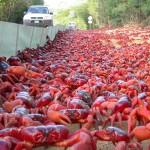Weekly Wrap Volume 18
 The Man Who was Stuck in the 1950s
The Man Who was Stuck in the 1950s
Henry Gustav Molaison, who came to be known by his initials, H.M., was studied from 1957 until his death in 2008. From an early age, H.M. suffered from severe epilepsy that was blamed on a bicycle accident when he was seven years old. He had seizures for many years that got progressively worse as he aged. The seizures finally got so bad that H.M was blacking out and could no longer work at his job assembling vehicle motors. He had to move in with his parents. At the age of 27 in 1953, H.M. was referred to… (more)
 The March of the Christmas Island Red Crab
The March of the Christmas Island Red Crab
As you can probably tell from its name, the Christmas Island red crab is a species of crab native to Christmas Island. Every year, millions of them will leave their forest burrows and swarm across the island to breed, leaving Christmas Island’s residents to deal with the consequences of their homes being overrun by crabs that outnumber the human populace almost 20,000 to 1. That last part isn’t hyperbole, according to the Australian census reports, Christmas Island has a population of just over 2000 people, whereas… (more)
 The Evolution of the Squirt Gun
The Evolution of the Squirt Gun
he modern, multi-coloured plastic water guns are a familiar sight, and you probably wouldn’t be surprised to find out they’ve been around for a while. That said, it might surprise you to learn that records show they likely pre-date the American Civil War, at least in some form or another. Back in 1861, Abraham Lincoln called for 75,000 volunteers to fight in the war. Boys were scrambling over each other trying to enlist first for fear that they might miss the conflict. They were doing… (more)
 Napoleon and the Invention of Margarine
Napoleon and the Invention of Margarine
Odds are you probably have a stick or a tub of it sitting in your fridge right now, but do you have any idea how margarine became a staple in most kitchens? It turns out, margarine has a long and controversial international history, and can even boast the involvement of Emperor Napoleon III in its invention. Margarine derives its name from a discovery in a chemist’s lab in France in 1813. Scientist Michel Eugène Chevreul uncovered a new fatty acid that he decided to call “acide margarique.” His discovery consisted of shiny, pearl-like deposits, so margarites seemed an apt name, as it is the Greek word for… (more)
 The Man Who Created James Bond Also Wrote Chitty Chitty Bang Bang
The Man Who Created James Bond Also Wrote Chitty Chitty Bang Bang
The man was Ian Fleming. Born May 28, 1908 to a wealthy family in London, he and his three brothers were educated at Eton College, the same school Princes William and Harry attended. Fleming was supposedly a master of athletics. After Eton, he attended Sandhurst and chose to study in Munich and Geneva, where he had the Alps as a backdrop. He would later learn to ski and climb the mountains, perhaps not surprising given his athletic history, which would also set the stage for some of his yet-to-be-conceived character in the James Bond books. Fleming jumped from career to career almost… (more)
Other Interesting Stuff:
- 10 Interesting Christmas Facts Part 1 [Infographic]
- 10 Interesting Christmas Facts Part 2 [Infographic]
Quick Facts:
- A contronym is a word that can be its own opposite; for example, “left” can mean to “depart” and “remain”.
- While it only takes 8 minutes and 19 seconds for the light from the surface of the Sun to reach Earth, it takes about 10,000-170,000 years for a photon to travel from the core of the Sun to the surface.
- Researchers in Israel have successfully trained mice to be used as bomb and drug detectors. The mice are kept in containers and if the mice detect any explosives or drugs, they will trigger an alarm by pressing a button. Each mouse can work in four hour shifts and have proven to be more accurate than x-ray machines and dogs at finding explosives and drugs.
- Menthol can be used in solid form as mineral ice, a substitute for real ice. As far as your brain is concerned, the drink you drink with the menthol is cold, even though it might actually be warm. This makes for handy “icing” of your drinks on camping trips.
- Tootsie Rolls were named after creator Leo Hirshfield’s five year old daughter whose nickname was “Tootsie” (her real name was Clara Hirshfield). Hirshfield set out to create a chocolate that wouldn’t melt easily and eventually came up with the artificial “chocolate” candy the tootsie roll. This ability to not melt easily and to use artificial ingredients that weren’t being rationed during war times proved a huge boon for the company as it eventually began being included in all soldier’s rations during WWII. The low price of the artificial ingredients also made it a popular treat during the depression along with the tootsie pop.
- A white dwarf is a former star that is nearing the end of its life-cycle, with no further nuclear fusion going on at its core. Once most stars have used up the fuel at their core, they go into a red-giant or red super-giant phase and expand to incredible sizes. At the end of this phase, when the star has used up all its fuel that it can use via nuclear fusion, if it has enough mass, it will extremely rapidly collapse and create one of the most powerful explosions in the universe, the supernova. The burst of energy from a single supernova can briefly out-shine an entirely galaxy full of billions of stars. If the red giant doesn’t have enough mass, it will simply collapse into a white dwarf and spend a couple billion years slowly dimming as it gives off its stored energy. Some star remnants are too small to begin with and so don’t ever go into a red giant phase. When they do go into their “red” phase, they are called “red dwarfs”. However, the lifespan of these stars is longer than the universe has existed. Thus, every star that will eventually become a red dwarf is still around today and has not reached the red dwarf phase. As a general rule with stars, the bigger and brighter it is, the faster it burns out. The smaller it is, the longer it lives.
This Week’s Podcasts:
- Podcast Episode #1: Columbus and the Round World
- Podcast Episode #2: Growing Up with Caffeine
- Podcast Episode #3: Cracking Knuckles and Arthritis
- Podcast Episode #4: Apples and Newton’s Head
- Podcast Episode #5: The Battleship and the Slinky
You Might Have Missed:
| Share the Knowledge! |
|




